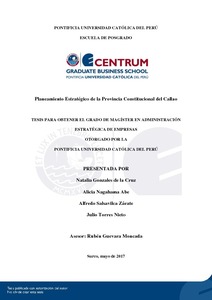Planeamiento estratégico de la Provincia Constitucional del Callao

View/
Date
2017-06-14Author
Gonzales de la Cruz, Natalia
Nagahama Abe, Alicia
Salsavilca Zárate, Alfredo
Torres Nieto, Julio
Metadata
Show full item recordAbstract
El presente Plan Estratégico aplicado a la Provincia Constitucional del Callao
fue elaborado a través del modelo secuencial de D’Alessio (2015), con una visión de
futuro para el año 2026. La meta, en este caso, es convertir la región en una ciudad
inteligente, que busca mejorar el bienestar y la calidad de vida de los ciudadanos, lo
cual pasa por analizar la situación de las instituciones, la sociedad, la economía, el
medio ambiente, la infraestructura y la tecnología; esta última sería un aspecto que
integraría a todos los grupos de interés, como el Gobierno, el sector privado y la
sociedad civil. En ese sentido, se encontró que existe una oportunidad para convertir la
región en un centro estratégico de interconexión del Perú, con servicios portuarios,
aéreos y logísticos competitivos, así como servicios turísticos, soportados con una
infraestructura social y productiva en alianza con Lima Metropolitana, con tecnología
de última generación para generar información para todos sus pobladores.
Sin embargo, la transformación de la Provincia Constitucional del Callao
requiere de estrategias que atiendan factores clave, como el fortalecimiento de la
seguridad ciudadana, la formalización de empresas, así como la ampliación del puerto
del Callao y del aeropuerto, sumado al desarrollo de vías de acceso que faciliten el
comercio y los servicios logísticos, y de infraestructura necesaria y servicios adecuados
para atender a los turistas extranjeros. Asimismo, se encontró que se debe reforzar el
acceso a las nuevas tecnologías que permitan la interconexión y el manejo de la
información en beneficio del gobierno regional y la comunidad en general, todo lo cual
se deberá desarrollar en un marco de sostenibilidad y cuidado del medio ambiente The Strategic Plan applied to the Callao Region was developed through
D’Alessio’s (2015) sequential model, with a vision for the future for the year 2026. The
goal, in this case, is to turn the region into a smart city, which seeks improving the
welfare and quality of life of citizens, which involves analyzing the situation of
institutions, society, economy, environment, infrastructure and technology; the latter
would be an aspect that would integrate all the stakeholders, such as the government,
the private sector and civil society. In that sense, it was found that there is an
opportunity to turn the region into a strategic interconnection center of Peru, with
competitive port, air and logistics services, as well as tourism services supported by a
social and productive infrastructure in alliance with Lima Metropolitana, with the last
generation in technology to generate information for all the inhabitants.
However, the transformation of the Callao Region requires strategies that
address key factors, such as the strengthening of citizen security, the formalization of
companies, as well as the expansion of the Callao port and the airport, together with the
development of access routes, facilitating trade and logistics services, and the necessary
infrastructure and adequate services to receive foreign tourists. Likewise, it was found
that access to new technologies needs to be reinforced, to allow the interconnection and
the handling of information should be strengthened for the benefit of the regional
government and the community in general, all this must be developed within a
framework of sustainability and care for the environment
Temas
Desarrollo regional -- Perú -- Callao
Planificación regional -- Perú -- Callao
Planificación estratégica
Planificación regional -- Perú -- Callao
Planificación estratégica
Para optar el título de
Magíster en Administración Estratégica de Empresas





